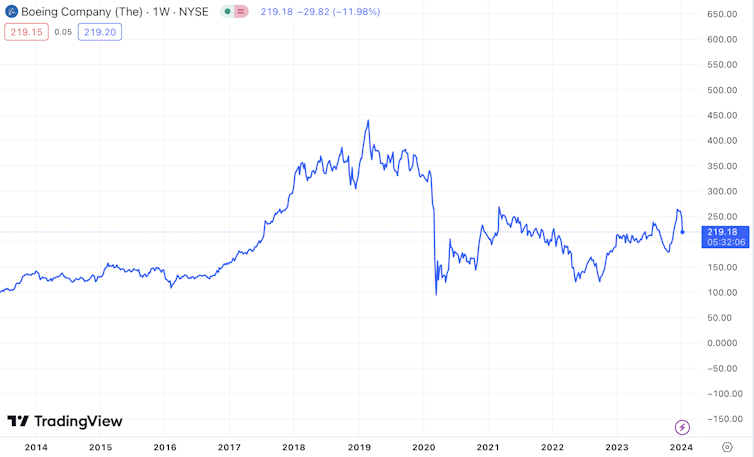The Boeing 737 Max is in the news again, this time because the door plug on a brand-new plane came off soon after take-off. The pilots of the Alaska Airlines flight from Portland, Oregon, managed to return the Max 9 safely to Portland International Airport, but the consequences would have been far more serious had the incident occurred at cruising height a few minutes later.
Alaska Airlines and fellow US carrier United Airlines have also discovered loose hardware and connections on their fleets of 737 Max planes. The US Federal Aviation Administration (FAA) has now grounded 171 Boeing aircraft, mostly operated by Alaska Airlines and United Airlines, pending inspections.
The 737 Max is a series of narrow-body commercial aircraft developed as an upgrade to the highly successful Boeing 737 Next Generation (NG) series. First delivered in 2017, it was designed to be even more fuel efficient and with more power supplied by bigger engines.
It has attracted more demand than Boeing can supply, but has faced significant challenges. Most notable were crashes in Indonesia (2018) and Ethiopia (2019), which were partly caused by technical problems and killed 346 people.
So why have there been all these problems and what can be done?
Design and manufacturing
An investigation following the Indonesia crash revealed issues with an automated flight control system called the Maneuvering Characteristics Augmentation System (MCAS). This was designed to prevent the 737 Max from stalling, which had been made more likely by its larger engines. Yet the system’s complexity and reliance on a single sensor made it vulnerable to failure.
The MCAS was also involved in the Ethiopian crash, albeit the US safety agency argued pilot errors were the main cause. Boeing subsequently issued a software fix for the MCAS problem. So far as we are aware, it has now been resolved.

Besides the most recent issues with Alaska and United, quality and safety problems have included unsatisfactory wing components in 2019. In 2023, suppliers were poorly attaching aircraft fittings and drilling unnecessary holes.
While these defects could be blamed on manufacturing, unwieldy designs make it difficult to manufacture products at scale while meeting quality requirements. So, you have to question whether poor design and unrealistically high volume expectations are ultimately what has happened to the 737 Max.
The fact that door plug problem and loose bolts are cropping up at a time when Boeing is trying to ramp up 737 Max production to about double the pre-pandemic level – and the pressure to achieve the pre-pandemic stock price – makes design all the more suspect.
Boeing share price:

Moreover, leaked internal documents from 2015-18 have revealed that employees who worked on the Max planes believed the design was unsound. Hundreds of internal messages showed them referring to the “piss-poor design” and one “designed by clowns” who were “supervised by monkeys”.
A US Congressional report in 2020 into the 737 Max crashes said: “Boeing failed in its design and development of the 737 Max, and the FAA failed in its oversight of Boeing and its certification of the aircraft.” It also pointed to too close a relationship with the FAA.
Boeing’s approach to manufacturing costs may also be a factor. Former employees previously suggested it had imported a culture that was very focused on cost-cutting when it bought rival US aerospace manufacturer McDonnell Douglas back in 1997. Boeing has denied that it has compromised on product safety or quality for any reason whatsoever.
Assembly line workers on the 737 Max have reportedly faced intense pressure to meet production deadlines, while a former senior manager claimed in 2019 he had sent urgent emails and letters to the company’s leadership to shut down production. Boeing has denied that assembly-line pressure had any bearing on the crashes, and pointed out that company’s commitment to safety was reflected in the fact that the whistleblower was able to brief its general counsel over his concerns.
Despite these alleged assembly-line issues, Boeing has not faced anything like the same problems with the other 737 variants or indeed with other planes like the 787 Dreamliner. Again, it indicates that the problem may ultimately be more to do with design of the 737 Max.
What next
So what happens now? Going by the previous debacles, the playbook is clear. The FAA will lift the grounding order in the coming weeks as politicians start complaining about orders being lost to Airbus. Boeing will swear all the planes are safe and that the production processes of the parts vendor in question, Kansas-based Spirit AeroSystems, have been reviewed (Spirit has said it is committed to ensuring every Boeing plane meets the highest safety and quality standards).
Then the White House will push developing countries to buy the Boeing 737 Max, as President Biden did in his visit with business leaders to Vietnam last September. All will be well – until it isn’t.
Instead, Boeing should suppress its political muscle and take a different approach. The 737 Max brand is so tarnished that it may be better to let go. More importantly, if the design is also ultimately unworkable at scale, it would be better to scrap it too rather than trying to push production even harder.
The good news for the company is that the 737 has been highly successful commercially going back to 1968, with a solid history of safety, not including the 737 Max. The 737 variants’ safety record until the end of 2019 was the same as the narrow-body offering from Airbus, including the A320, but it has now become much worse with the 737 Max.
Boeing should arguably design a new narrow-body plane again based on the 737 Next Generation with higher efficiency and larger engines. The supply chain won’t need to be changed dramatically. It worked for previous 737s, so there is no reason it can’t work again. If cost-cutting has resulted in suppliers cutting too many corners, that needs to be revisited of course.
Boeing President and CEO Dave Calhoun said at an all-employee safety meeting on January 9: “We’re going to have to demonstrate trust by our actions, by our willingness to work directly and transparently with them (customers).”
This is true, but the company’s first priority has to be to make sure it has the trust of its workers by listening to their safety concerns and taking them onboard.
Only by addressing its culture can Boeing really end this crisis. There has been such a catalogue of sequential errors that anything short of a complete overhaul is only likely to compound the problem and put more lives at risk.

